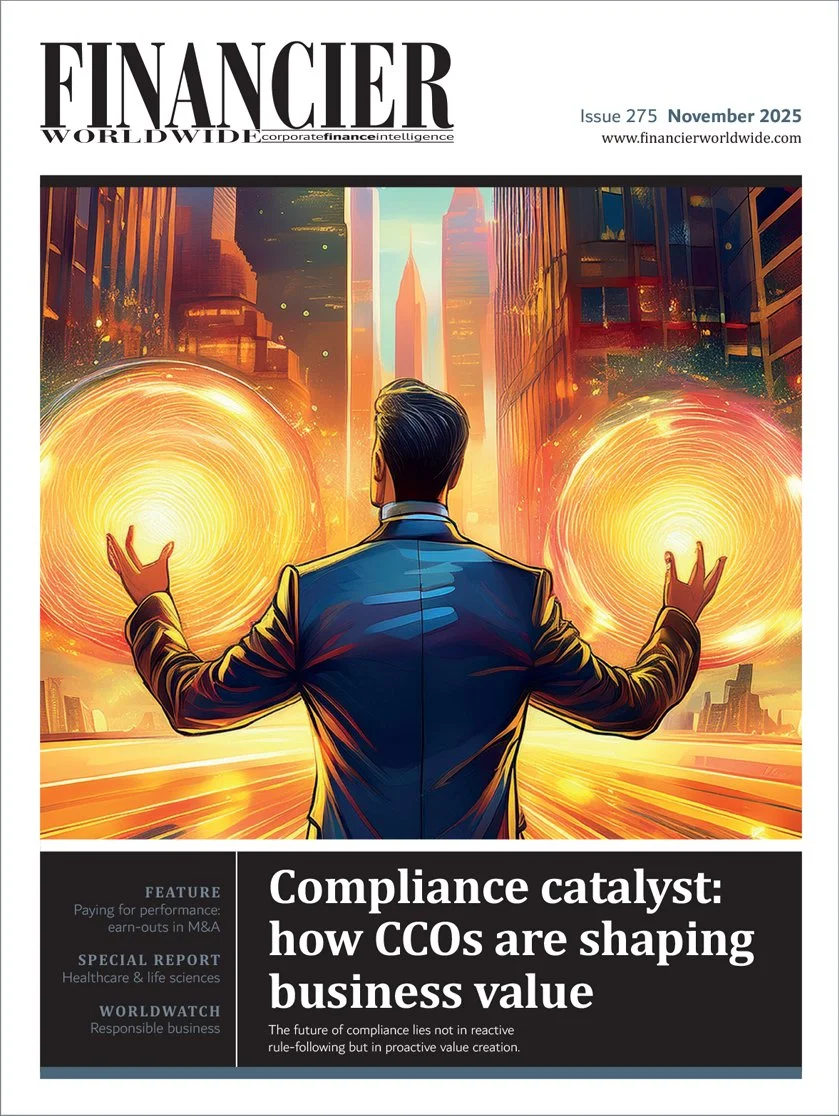Appropriate measures: damages quantification in international arbitration
November 2025 | FEATURE | LITIGATION & DISPUTE RESOLUTION
Financier Worldwide Magazine
The intention of justice is that a wrong is put right – claims being judged on merit and without prejudice – and for the guilty party or parties to be punished, with suitable recompense awarded to those injured.
Quantifying an award for damages, however, is no easy matter. In the context of international arbitration, quantification is a complex and dynamic field that demands expertise in financial principles, industry-specific challenges and ethical considerations.
Central to the success or failure of arbitral proceedings – dependent on the perception of the parties in dispute – is the amount of damages awarded. Damages quantification, therefore, constitutes a critical component in giving effect to parties’ rights and obligations under international arbitration.
“I have observed increasing sophistication in how damages are being assessed,” says Felipe Isore Gutierrez, founder and managing partner at CONEXIG. “Arbitral tribunals now expect not only rigorous cost quantification but also more transparency and more clearly established causality. As claims grow in value and complexity, interdisciplinary and data-driven approaches are becoming essential for credible damage quantification.”
Despite its growing sophistication, the process of quantifying damages in international arbitration – as well as in other spheres – often does not receive the attention it deserves. This inadequacy is best addressed through an exploration of quantification methodologies.
Types of damages
In assessing economic harm and awarding appropriate damages, the first step is to select a suitable damages framework. International arbitration disputes frequently involve claims of asset expropriation, lost profits or a combination of the two. This framework helps to identify the various types of damages that may be awarded to compensate the injured party for the harm or loss suffered.
According to analysis by Skadden, Arps, Slate, Meagher & Flom in ‘Compensatory Damages Principles in Civil and Common Law Jurisdictions: Requirements, Underlying Principles and Limits’, the types outlined below, which differ from jurisdiction to jurisdiction, constitute typical damages scenarios.
First, actual loss suffered and lost profits. These are distinct concepts originating from Roman law. Actual loss, also known as damnum emergens, refers to the direct, out-of-pocket expenses incurred due to a breach or violation. Lost profits, or lucrum cessans, represent the anticipated profits that were not realised because of the same breach or violation.
Second, direct and consequential damages. Direct damages compensate for the immediate consequences of a breach of contract. Consequential damages, by contrast, compensate for losses that may not be a direct consequence but stem indirectly from the breaching conduct. What qualifies as direct damages in one contract may be classified as indirect or consequential damages in another.
Third, expectation and reliance damages. Expectation damages compensate a party for the value of the benefit the party would have received had the contract been properly performed. Reliance damages – also referred to as wasted expenditures – allow the non-breaching party to recover any costs or expenses incurred in reliance on the breaching party’s promises.
Lastly, pecuniary and non-pecuniary damages. Expectation and reliance damages are intended to provide redress for the non-breaching party’s pecuniary loss – that is, losses that can be reduced to monetary terms. In addition to pecuniary damages, compensation may also be available to remedy non-material harm such as mental suffering, loss of social standing or damage to reputation.
An arbitrator’s checklist
To derive a proper assessment of damages, there are key economic considerations for arbitral tribunals to take into account. A checklist should reflect the law governing the substance of the dispute between the parties and how damages are applied.
“A checklist should include discounted cash flow (DCF) analysis, market-based methods and asset and cost-based approaches – and the reasons for selecting a particular valuation methodology,” says Sophie Nappert, an international arbitrator at 3 Verulam Buildings. “Gaining this knowledge is even more important given the growing proliferation of digital assets and business models where factors such as the absence of physical assets or predictable revenue streams, as well as the lack of historical data, take damage assessment to a new frontier.”
“The role of the expert will remain pivotal – not merely as a calculator of losses but as a guide through the intricacies of financial logic and legal reasoning.”
Additional items on Ms Nappert’s checklist for arbitrators include the assumptions underpinning the chosen damage assessment methodology, such as the discount rate and country risk in DCF analyses, the economic modelling of the counterfactual, the valuation date and the amount of interest that may be awarded – an issue Ms Nappert notes is rarely pleaded.
Summarising the checklist, Mr Gutierrez observes that arbitrators typically seek three fundamentals: clear linkage between the event and economic outcome (causation), grounded assumptions and a credible quantification method. “Arbitrators value consistency in source data, clarity in the construction of counterfactuals, and explicit acknowledgment of any uncertainties,” he contends. “The goal is to ensure that any estimated damage is not only measurable but objectively explained and supported.”
Expert determination
In cases where an assessment of damages involves understanding technical and industry-specific matters in which arbitrators may have little or no experience, the need for a damages expert becomes paramount. Such individuals possess knowledge that can greatly assist parties, counsel and the arbitral tribunal.
“Expert testimony is of tremendous importance,” suggests Ms Nappert. “An experienced expert will break down their analysis in incremental steps that allow the tribunal to follow each underpinning assumption and the logic behind it.
“An experienced expert will confront the points made against their case and rebut them,” she continues. “Experts on both sides will meet and provide the tribunal with a joint statement streamlining the issues that remain in dispute, and the reasons why.”
In its ‘The Role of a Damages Expert in the Evaluation of Damages in International Commercial Arbitration’, the International Bar Association highlights several key factors for parties to consider when selecting a damages expert.
These include the amount in dispute – in cases involving small amounts, it may not be financially reasonable to engage damages experts. The complexity of the damages issues is also relevant. When the facts and issues are easily understood, a damages expert may not be required. However, when the issues are complex and the tribunal may not be versed in the sophisticated concepts involved in assessing damages in that particular industry, a damages expert should be selected.
The expert’s credentials are critical. Industry familiarity and prior experience in the specific type of dispute being dealt with are advantageous. The expert must also possess strong verbal and written communication skills, enabling them to explain complex issues clearly and persuasively in terms that a tribunal can understand.
Experience testifying in arbitral proceedings is another advantage, as it equips the expert to understand the intricacies of how a case works and what to expect in cross-examination. The expert’s demeanour and credibility while testifying also matter.
A party’s financial resources and ability to pay for a damages expert must be considered. In jurisdictions where third-party funding is available, the decision to appoint a damages expert is easier. Where it is not permitted, a party must weigh the cost of appointing one against the potential loss it may suffer or the amount it may recover.
Independence and impartiality are fundamental. A party appointing a damages expert should investigate whether a potential expert has previously worked for or has any other relationship with any of the parties, counsel (including opposing counsel) or arbitrators.
“The most effective experts offer more than calculations – they offer clarity, objectivity and contextual understanding,” opines Mr Gutierrez. “Tribunals value professionals who explain methodologies in accessible terms, engage with the evidence as it stands, and remain independent. Experts bring clarity and usefulness in bridging financial analysis with construction performance data. Deep sectoral knowledge, paired with neutrality, is what distinguishes credible experts from persuasive advocates.”
Evaluation challenges
One of the most significant challenges facing arbitrators is bridging the often substantial disparity in the outcome of the quantification of damages claims by claimants and respondents.
“The greatest challenge arises from divergence in experts’ assumptions, particularly around causation, mitigation and operational context,” states Mr Gutierrez. “I have seen damages overstated due to unsupported productivity factors or failure to consider cost-saving measures actually taken.
“Tribunals often face difficulty reconciling these gaps,” he continues. “The role of experts is to produce transparent, structured work that allows fact-finders to identify the core drivers of harm and distinguish between what is supported by the evidence and what is speculative or overstated.”
Illustrating Mr Gutierrez’s contention is research by PwC, in collaboration with Queen Mary University of London, which found that damages are often quantified at a much lower percentage of the claimed amount – sometimes as low as 10 to 12 percent. This disparity puts pressure on tribunals to navigate these opposing positions and determine an appropriate award.
Evolving damages analysis
The approach to damage quantification in international arbitration cases is evolving rapidly, with a multitude of technological and societal developments impacting how damages claims are assessed and awarded.
Among these, suggests Ms Nappert, are climate-related issues and environmental, social and governance (ESG) obligations – especially within the mining, energy and infrastructure sectors. She asserts that these may lead to the introduction of hybrid damages models that incorporate the cost of environmental remediation, community displacement or regulatory compliance.
Also challenging traditional valuation methods, continues Ms Nappert, are cryptocurrencies, non-fungible tokens, algorithms and digital platforms. Blockchain-based businesses and platform economies demand new methods of asset tracing and valuation in the absence of a stable market.
“The adoption of artificial intelligence (AI) is rapidly transforming how damages are assessed in international arbitration,” suggests Mr Gutierrez. “AI tools are being applied to streamline data extraction, identify causation patterns in disruption events, and simulate cost or productivity impacts, which is especially useful in large, document-heavy cases. These innovations offer significant gains in efficiency and analytical depth.
“However, they also introduce new risks, notably around confidentiality, data privacy, algorithmic transparency, and ethical and proper use of such tools,” he continues. “Ensuring secure handling of sensitive case data and avoiding bias or overreliance on black-box models will be critical. Looking forward, digital integration, ESG-linked damages and higher evidentiary expectations will likely define the next era of expert work.”
In the evolving landscape of international arbitration, the quantification of damages has become both a science and an art. As tribunals grapple with increasingly complex claims, the need for precision, transparency and interdisciplinary insight has never been greater. From traditional valuation models to emerging challenges posed by digital assets and ESG obligations, the field demands not only technical expertise but also a deep understanding of context and causality. Arbitrators must navigate divergent expert opinions, reconcile speculative assumptions and ensure that awards reflect genuine economic harm rather than inflated projections.
Looking ahead, the integration of AI, the rise of hybrid damages frameworks and the growing emphasis on evidentiary rigour will continue to reshape how damages are assessed. The role of the expert will remain pivotal – not merely as a calculator of losses but as a guide through the intricacies of financial logic and legal reasoning. In this dynamic environment, clarity, credibility and consistency will be the cornerstones of effective dispute resolution.
© Financier Worldwide
BY
Fraser Tennant


